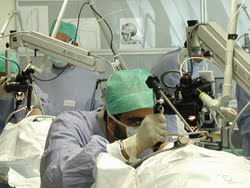A robotic micromanipulator is controlled by software to make predefined incisions.
Amy Beck and Hacki Hecht, Lumenis Inc.
The CO2 laser has long been a therapeutic workhorse in hospitals and physicians’ offices. It is suited for surgical applications, including precise incision and excision procedures, as well as for ablative procedures, such as tissue debulking and high-precision laser skin resurfacing.
The CO2 laser allows surgeons to cut smoothly through soft tissue, while limiting heat diffusion to surrounding tissue. Collateral damage is limited to 25 μm from the point of incision. Dr. Mark Courey, a San Francisco-based laryngologist specializing in treatment of disorders affecting the voice, airway and swallowing, uses CO2 lasers in his practice. He is the director of the University of California, San Francisco, Voice Center and a professor in the university’s department of otolaryngology, head and neck surgery.
Courey recently used the laser to operate on a patient suffering from grade-4 laryngotracheal stenosis, who could not talk. The result of trauma 10 years prior, the condition was exacerbated by multiple injudicious surgical interventions. Additional trauma from repetitive surgeries had produced inflammatory scarring called cicatrix, which resulted in granulating, nonresolving inflammation and the buildup of fibrous tissue. Cicatricial scarring becomes more obtrusive with time and can be life-threatening when it occurs in the narrow structure of the larynx.

A minimally invasive laryngeal surgical procedure uses a robotic microsurgery laser system.
This difficult case required two specialized surgical interventions. In the first, Courey used the UltraPulse SurgiTouch CO2 laser from Lumenis Ltd. of Yokneam, Israel. The laser had a specifically equipped bronchoscope with an integrated micromanipulator, a lightguide and optics designed to expose the stenosis. The lightguide is a rigid fiber optic bundle connected via a flexible light cable to a halogen/xenon light source from Stryker Corp. of Kalamazoo, Mich. Courey used single laser pulses to quickly cut through the stenotic tissue, while preserving surrounding healthy tissue.
The secondary intervention involved resection of the vocal folds. For this delicate procedure, Courey used the Lumenis AcuBlade scanning micromanipulator, which adds robotic capabilities for microsurgery. It combines the computerized laser scanning system with an operating microscope. Surgeons can predefine the incision length, and it automatically performs designated cutting patterns, controlled by the software.
These devices offer physicians opportunities to perform procedures they may not have conducted before and can fundamentally change the way they provide treatment. In this case, the doctor’s interventions were highly successful: Having been mute for more than a decade, the patient received the gift of speech.
Meet the authors
Amy Beck is a product manager and Hacki Hecht is a marketing manager, both in the Ent/Gyn department at Lumenis Inc. in Santa Clara, Calif.; e-mail: [email protected]; [email protected].